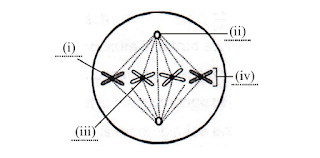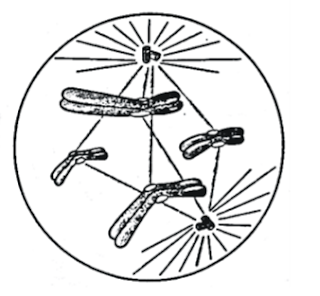Cell Cycle and Cell Division NEET Questions Pdf Download :
Cell cycle and Cell Division NEET Questions is Scoring topic where candidates can attempt to solve maximum number of accurate questions and increase their overall score count in the NEET exam. Not only in NEET exams but in other competitive exams as well, Cell cycle and Cell Division is considered to be the most scoring Scoring and Simple Chapter. The aim of this Chapter Cell cycle and Cell Division MCQ is to test candidates’ awareness and knowledge regarding the Cell cycle and Cell Division.
These NEET Questions on Cell cycle and Cell Division for class 12 Pdf Download will help students score in the upcoming NEET exam and perform better in competitive exams, such as CET, NET, SET. Hence, it is suggested to students to solve all these Cell cycle and Cell Division Questions for NEET with their problem-solving skills and cross-check the answers. Also, try to maintain a time limit for each question. Below is the list of all the Important MCQ on Cell cycle and Cell Division. Here you can get the MCQs with answers and also download PDFs provided for each topic for extra MCQ on Cell cycle and Cell Division to practise more.
NEET Questions on Cell Cycle and Cell Division :
1. First gap phase in cell cycle is_____
(1) interval between mitotic phase and DNA replication phase
(2) interval between DNA replication phase and DNA separation phase
(3) interval between karyokinesis and cytokinesis
(4) interval between DNA replication phase and second gap phase
Answer: 1
Read : Chemical Coordination and Integration NEET MCQs
2. The two chromatids of a metaphase chromosome represent________
(1) replicated DNA to be separated at anaphase
(2) non homologous chromosomes joined at the centromere
(3) pair of homologous chromosomes
(4) maternal and paternal chromosomes joined at the centromere
Answer: 1
3. Synaptonemal complex is a nucleoprotein structure. It is visible or found from________
(1) zygotene to pachytene
(2) leptotene to diplotene
(3) zygotene to metaphase
(4) pachytene to diplotene
Answer: 1
Read : Diversity in Living World NEET MCQ
4. Which one of the following is correctly matched?
(1) Leptotene - formation of bivalents
(2) Diplotene - chiasmata appear
(3) Pachytene - chiasmata terminalisation
(4) Zygotene - formation of bouquet
Answer: 2
3. In which stage of meiosis, chromosomes are thin, long, thread like?
(1) Zygotene
(2) Leptotene
(3) Pachytene
(4) Diakinesis
Answer: 2
Read : Human Reproduction NEET Questions
4. Label the structure indicated by (i), (ii), (iii) and (iv)________
(1) (i)-Chromatid, (ii)-Centriole, (iii)-Centromere, (iv)-Chromosome
(2) (i)-Chromosome, (ii)-Centriole, (iii)-Centromere, (iv)-Chromatid
(3) (i)-Chromatid, (ii)-Centromere, (iii)-Centriole, (iv)-Chromosome
(4) (i)-Chromosome, (ii)-Centromere, (iii) Centriole, (iv)-Chromatid
Answer: 1
5. Meiosis involves_______
(1) one nuclear divisions and one chromosome division
(2) two nuclear divisions and one chromosome division
(3) one nuclear division and two chromosome divisions
(4) two nuclear divisions and two chromosome divisions
Answer: 2
Read : Microbes in Human Welfare NEET MCQ
6. In meiosis, centromeres of chromosomes divide during_________
(1) anaphase of meiosis-II
(2) metaphase of meiosis-I
(3) anaphase of meiosis-I
(4) prophase of meiosis-II
Answer: 1
7. The drawing below shows a cell whose diploid chromosome number is four. This cell is in___________
(1) Metaphase of mitosis
(2) Anaphase of mitosis
(3) First anaphase of meiosis
(4) Second anaphase of meiosis
Answer: 3
Read : Molecular Basis of Inheritance MCQ
8. A cell that is entering the mitotic phase (M-phase) of cell cycle is______
(1) always haploid and with duplicated chromosomes
(2) either haploid or diploid and with duplicated chromosomes
(3) either haploid or diploid and with duplicated or unduplicated chromosomes
(4) always diploid and with unduplicated chromosomes
Answer: 2
9. A cell examined during prophase of cell cycle contained 100 units of DNA and 50 chromosomes. What would be the number of DNA and chromsomes in anaphase of this cell cycle?
(1) 200 DNA & 100 chromosomes
(2) 100 DNA & 50 chromosomes
(3) 100 DNA & 100 chromosomes
(4) 50 DNA & 25 chromosomes
Answer: 3
10. Which type of chromosome is present in the prophase of cell cycle?
(1) 2 chromatid
(2) 1 chromatid
(3) 4 chromatid
(4) 8 chromatid
Answer: 1
11. Which does not occurs in prophase ?
(1) Decondensation of chromatin
(2) Condensation of chromatin
(3) Appearance of chromosome
(4) Disappearance of nuclear membrane and
nucleolus
Answer: 1
12. Identify the following diagram________
(1) Transition to Metaphase (mitosis)
(2) Transition to Anaphase-II (meiosis)
(3) Transition to Metaphase-I (meiosis)
(4) Transition to Anaphase (mitosis)
Answer: 1
13. In which stage of cell division, number of chromosomes best counted_______
(1) Prophase
(2) Metaphase
(3) Telophase
(4) Interphase
Answer: 2
14. How many chromosome shall be present in a diploid cell at mitotic anaphase if its egg cell has ten chromosome______
(1) 10 (Ten)
(2) 20 (Twenty)
(3) 30 (Thirty)
(4) 40 (Forty)
Answer: 4
15. Chromosome exhibit high level of coiling at which phase of karyokinesis______
(1) Prophase
(2) Metaphase
(3) Telophase
(4) Interphase
Answer: 2
16. Which one of the following is most correct statement______
(1) Chromatin material tends to collect in a mass in the two poles
(2) Each set of chromatin material tends to collect at each of the two poles
(3) Each set of chromatin material tends to collect at metaphasic plate
(4) Chromatin material tends to collect in a mas at one pole
Answer: 2
17. Nuclear envelop develops around the chromosome clusters at______
(1) One pole
(2) Centre
(3) Each pole
(4) Pole as well as centre both
Answer: 3
18. Cytokinesis is______
(1) Formation of cell wall
(2) Formation of cell membrane
(3) Separation of nucleoplasm
(4) Separation of cytoplasm
Answer: 4
19. Meiosis involves______
(1) Pairing of homologous chromosomes and recombination between sister chromatids of nonhomologous chromosomes
(2) Pairing of homologous chromosomes and recombination between nonsister chromatids of homologous chromosomes
(3) Pairing of nonhomologous chromosomes and recombination between nonsister chromatids of homologous chromosomes
(4) Pairing of homologous chromosomes and recombination between sister chromatids of homologous chromosomes
Answer: 2
20. In which of the following stages of mitosis, chromosomes are most condensed ?
(1) Stage between the stage of cell plate formation and stage of DNA replication
(2) Stage between the stage of centrioles separation and stage of splitting of centromere
(3) Stage between the stage of DNA replication and stage of initiation of condensation of chromatin
(4) Stage between the stage of metaphase plate formation and stage of decondensation of chromosomes
Answer: 2
21. If the cell had diploid or 2n number of chromosomes at G1, after S phase the number of chromosomes in the cell is ?
(1) 2 n
(2) 4 n
(3) n
(4) 3n
Answer: 1
22. Anaphase Promoting Complex (APC) is a protein degradation machinery necessary for proper mitosis of animal cells. If APC is defective in a human cell, which of the following is expected to occur ?
(1) Chromosomes will be fragmented
(2) Chromosomes will not segregate
(3) Recombination of chromosome arms will occur
(4) Chromosomes will not condense
Answer: 2
23. Many cells function properly and divide mitotically even through they do not have______
(1) Plasma membrane
(2) Cytoskeleton
(3) Mitochondria
(4) Plastids
Answer: 4
24. Centromere is required for______
(1) Movement of chromosomes towards poles
(2) Cytoplasmic cleavage
(3) Crossing over
(4) Transcription
Answer: 1
25. At which stage of the cell cycle are histone proteins synthesized in a eukaryotic cell ?
(1) During telophase
(2) During S–phase
(3) During G2–stage of prophase
(4) During entire prophase
Answer: 2
26. If the n=16 in plant cell then what is possible in metaphase - I of meiosis ?
(1) 32 Bivalents
(2) 16 Telravalents
(3) 16 Bivalents
(4) 32 Bivalents
Answer: 3
27. Prophase which follows the S and G2 phases of interphase, is the first stage of__________
(1) Meiosis-II
(2) Karyokinesis
(3) Interphase
(4) G1 phase
Answer: 2
28. The two asters together with spindle fibres form_________
(1) Mitotic apparatus
(2) Asters
(3) Astral fibres
(4) Centrosome
Answer: 1
29. In prophase centrosome which had undergone duplication during interphase, begins to move towards______
(1) Same poles of the cell
(2) Opposite poles of the cell
(3) One towards centre while another towards pole
(4) Both towards centre
Answer: 2
30. During prophase each centrosome radiates out microtubules called___________
(1) Mitotic apparatus
(2) Spindle apparatus
(3) Asters
(4) Spindle fibres
Answer: 3
31. Telophase is______
(1) Final stage of karyokinesis
(2) Final stage of mitosis
(3) Mid stage of karyokinesis
(4) First stage of cytokinesis
Answer: 1
32. During which stage a diploid cell becomes tetraploid in mitosis_________
(1) G2
(2) Prophase
(3) Metaphase
(4) Anaphase
Answer: 4
33. Division of centromere occurs in_________
(1) Prophase
(2) Metaphase
(3) Anaphase
(4) Telophase
Answer: 3
34. Each chromosome composed of one chromatid in__________
(1) Anaphase – I
(2) Anaphase – II
(3) Metaphase – I
(4) Metaphase – II
Answer: 2
35. If the number of bivalents are 8 in metaphase – I, what shall be the number of chromosomes in daughter cells after meiosis – I and meiosis – II respectively_________
(1) 8 and 4
(2) 4 and 4
(3) 8 and 8
(4) 16 and 8
Answer: 3
36. Which of the following not ocurs in Anaphase–I but occurs in Anaphase–II__________
(1) Condensation of chromosomes
(2) Poleward movement of chromosome
(3) Contraction of spindle fibers
(4) Splitting of centromere
Answer: 4
37. During G2 - phase a diploid cell contains the amount of DNA equal to a_______
(1) Diploid cell
(2) Tetraploid cell
(3) Haploid cell
(4) None of the above
Answer: 2
38. Crossing over takes place in__________
(1) Zygotene
(2) Pachytene
(3) Diplotene
(4) Diakinesis
Answer: 2
39. A contractile mid body forms during cytokinesis in__________
(1) Animals
(2) Higher plants
(3) Fungi
(4) Algae
Answer: 1
40. In which order, cytokinesis occurs in plants_______
(1) Centripetal
(2) Centrifugal
(3) Oblique
(4) Equatorial
Answer: 2
41. Which of the two events restore the normal number of chromosomes in life cycle ?
(1) Mitosis and Meiosis
(2) Meiosis and fertilisation
(3) Fertlisation and mitosis
(4) Only meiosis
Answer: 2
42. Which one of the following statements is correct ?
(1) Cell divided by cytokinesis only in mitosis
(2) DNA is replicated before the start of meiosis only
(3) Spindles consisting of microtubules are formed only in mitosis
(4) Exchange of genetic materials occurs only in meiosis
Answer: 4
43. Which of the following not occurs in Anaphase –I
(1) Segregation of homologous chromosomes
(2) Shortening in spindle
(3) Poleward movement of chromosomes
(4) Division of centromere
Answer: 4



